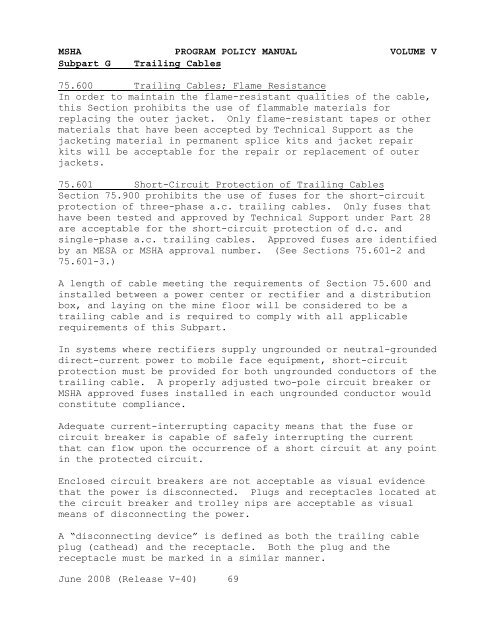Program Policy Manual - VOLUME V - Mine Safety and Health ...
Program Policy Manual - VOLUME V - Mine Safety and Health ...
Program Policy Manual - VOLUME V - Mine Safety and Health ...
Create successful ePaper yourself
Turn your PDF publications into a flip-book with our unique Google optimized e-Paper software.
MSHA PROGRAM POLICY MANUAL <strong>VOLUME</strong> V<br />
Subpart G Trailing Cables<br />
75.600 Trailing Cables; Flame Resistance<br />
In order to maintain the flame-resistant qualities of the cable,<br />
this Section prohibits the use of flammable materials for<br />
replacing the outer jacket. Only flame-resistant tapes or other<br />
materials that have been accepted by Technical Support as the<br />
jacketing material in permanent splice kits <strong>and</strong> jacket repair<br />
kits will be acceptable for the repair or replacement of outer<br />
jackets.<br />
75.601 Short-Circuit Protection of Trailing Cables<br />
Section 75.900 prohibits the use of fuses for the short-circuit<br />
protection of three-phase a.c. trailing cables. Only fuses that<br />
have been tested <strong>and</strong> approved by Technical Support under Part 28<br />
are acceptable for the short-circuit protection of d.c. <strong>and</strong><br />
single-phase a.c. trailing cables. Approved fuses are identified<br />
by an MESA or MSHA approval number. (See Sections 75.601-2 <strong>and</strong><br />
75.601-3.)<br />
A length of cable meeting the requirements of Section 75.600 <strong>and</strong><br />
installed between a power center or rectifier <strong>and</strong> a distribution<br />
box, <strong>and</strong> laying on the mine floor will be considered to be a<br />
trailing cable <strong>and</strong> is required to comply with all applicable<br />
requirements of this Subpart.<br />
In systems where rectifiers supply ungrounded or neutral-grounded<br />
direct-current power to mobile face equipment, short-circuit<br />
protection must be provided for both ungrounded conductors of the<br />
trailing cable. A properly adjusted two-pole circuit breaker or<br />
MSHA approved fuses installed in each ungrounded conductor would<br />
constitute compliance.<br />
Adequate current-interrupting capacity means that the fuse or<br />
circuit breaker is capable of safely interrupting the current<br />
that can flow upon the occurrence of a short circuit at any point<br />
in the protected circuit.<br />
Enclosed circuit breakers are not acceptable as visual evidence<br />
that the power is disconnected. Plugs <strong>and</strong> receptacles located at<br />
the circuit breaker <strong>and</strong> trolley nips are acceptable as visual<br />
means of disconnecting the power.<br />
A “disconnecting device” is defined as both the trailing cable<br />
plug (cathead) <strong>and</strong> the receptacle. Both the plug <strong>and</strong> the<br />
receptacle must be marked in a similar manner.<br />
June 2008 (Release V-40) 69
















